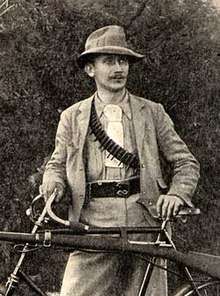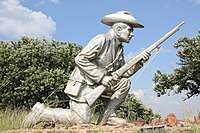Daniel Theron
Daniël Johannes Stephanus "Danie" Theron, (9 May 1872 – 5 September 1900) was a Boer Army military leader. Born in Tulbagh, Cape Colony, he was raised in Bethlehem, Orange Free State. He is best known as the driving force behind the formation of a military bicycle corps used by the Boer Army for scouting and relaying messages. Originally trained as a school teacher, he became a lawyer and notary with his own law firm in Krugersdorp, Transvaal Republic, and was made a Captain in the Boer Army when the Second Boer War began. During the war, he was put in charge of a significant scouting unit, the Theron se Verkenningskorps (TVK) (Theron Reconnaissance Corps). He fought at the Battle of Spion Kop and one of his most famous feats occurred at the Battle of Paardeberg.[1] The British Commander in Chief, Lord Roberts, called Theron: "the hardest thorn in the flesh of the British advance", put a reward of £1,000 on his head – dead or alive – and dispatched 4,000 soldiers to find and eliminate the TVK.[2]
Danie Theron | |
|---|---|
 Theron as Commandant of the Wielrijders Rapportgangers Corps, 1899 | |
| Birth name | Daniël Johannes Stephanus Theron |
| Born | 9 May 1872 Tulbagh, Cape Colony |
| Died | 5 September 1900 (aged 28) Gatsrand, South African Republic (near Fochville) |
| Allegiance | |
| Years of service | 1899–1900 |
| Rank | Captain |
| Unit | Scout |
| Commands held | Theron se Verkenningskorps (Theron Reconnaissance Corps), South African Republic |
| Battles/wars | Malaboch War Second Boer War: -- Battle of Paardeberg -- Spioen kop |
| Other work | School teacher, lawyer |
Early life
Theron was the ninth of fifteen children of Charlise Helena Margaretha (née Krige) and Willem Wouter Theron.[3] He began his career as a school teacher but later earned a law degree and started his own practice. Before the Second Boer war, Theron was a commando in the 1894 Malaboch War, and he trained scouts for reconnaissance until 1899. By his contemporaries, Theron was said to be slight, wiry, with a dark complexion, and short-tempered.[4] He was a South African Freemason.[5]
Second Boer War
Theron became a Boer Army Captain and was put in charge of organizing and leading the Boer Intelligence scouts, the Theron se Verkenningskorps (TVK) (Theron's Reconnaissance Corps).[6] To save horses for combat, he developed the use of bicycles for despatch and reconnaissance. His 105 recruits were equipped with various items including revolvers, binoculars and sometimes light carbine. The TVK would watch British movements and study their tactics during battles.
Reconnaissance missions became Theron's specialty. He was able to move through the land without being detected. As the war progressed, Theron and his men were moved closer to the Western front. The Boers, under the rule of Piet Cronje, were constantly skirmishing with British forces, and the TVK gained a reputation for destroying railway bridges. Lord Roberts labelled Theron "the chief thorn in the side of the British.". A bounty was put on his head for £1,000 offered for his capture.
Theron's most notable single action was in the Battle of Paardeberg, where on 25 February 1900, a Boer Gen. Piet Cronje and several thousand troops were surrounded by British forces. Outnumbered and losing the battle, Theron, acting as a messenger for the other primary Boer commander, sneaked through British lines to convey a plan for a breakout operation - and then sneaked through the lines a second time to bring back Cronje's reply. The TVK brought many Boer civilians and soldiers across the river safely into Boer territory, but in spite of Theron's efforts the planned operation failed and most of the Boer forces surrendered.
— Frederick Russell Burnham, Chief of Scouts for the British Army in the Second Boer War (1900).[7]
After the British occupied parts of the Orange Free State in March 1900, Theron and the TVK became well known for the guerrilla campaign they conducted against the British Army. The TVK attacked trails and rail yards, ambushed and captured British soldiers and officers, blew up bridges, and freed captured Boer fighters from British prisons. On two separate occasions while scouting in the veldt in no-man's land, Theron came upon the British Army Chief of Scouts, the American Frederick Russell Burnham.[7] Both times the two men exchanged fire, but only at a distance.[7]
In July 1900, the British dispatched a unit of 4,000 soldiers to find and eliminate the TVK. After one skirmish with this force on 19 July, Theron managed to evade his pursuers and continue raiding, but the TVK was always on the run.
Death
While scouting alone on a koppie at Gatsrand, about 6 kilometres (3.7 mi) north of present-day Fochville, he encountered seven members of Marshall's Horse and was killed in action. According to the source, Daniel almost ran into the cavalry platoon, but he reacted and opened fire so swiftly that he nearly eliminated the entire squad of seven, killing three and maiming four. Unfortunately, his gunfire drew attention to the escorting artillery, and the field guns opened a barrage on the koppie that killed him.[2][8] General de Wet remarked "Men as lovable or as valiant there might be, but where shall I find a man who combined so many virtues and good qualities in one person?"[9]
On 15 September 1900, the men of the TVK exhumed the body of their Commandant and reburied him in the family cemetery of the Pienaar family near Fochville. But on 10 March 1903, Theron's last will was carried out and his body was once again exhumed to be reburied next to that of his late fiancée Hannie Neethling on her father's farm Eikenhof on the Klip (Rock) River.[2]
Legacy

On 28 December 1907, Generals Louis Botha and Jan Smuts unveiled the Danie Theron Monument near Potchefstroom.
On 9 September 1950, a monument was unveiled at the location where Danie Theron died (near the N12 road between Johannesburg, South Africa and Potchefstroom). The monument has the following symbolism:
- the main body consists of 50 concrete rings, which represents the 50 years since September 1900 when Danie Theron died; and
- a copper flame at the top of the structure represents the flame which burned in the hearts of Theron and his nation, in search of their freedom and independence.
The monument was built by L. Fokkens (Pty) Ltd. according to plans of the architect Mr. Hillebrands (from Krugersdorp). Funds for the monument were collected by the Voortrekkers organisation.
A new Danie Theron Monument was erected near the Union Building in Pretoria, South Africa on 6 March 2002, by the former South African President Nelson Mandela. In one of the very rare occasions where Mr. Mandela spoke Afrikaans in public, he said he valued the fighting spirit of Danie Theron, his honesty, bravery and his determination to do the right thing for his nation and his beliefs. Mr. Mandela said that the modern South Africa needs more Danie Therons in order to meet the challenges that lie ahead.[2][10]
One of the primary schools in Carletonville was named in honour of this Boer hero, i.e. Laer Gedenkskool Danie Theron. A smaller replica of the monument (found on the hill near Fochville) was also erected on the school grounds, near the main entrance.
A Commando Combat School was established at Kimberley, South Africa on 1 November 1967 and in 1968 it was renamed the Danie Theron Combat School.[2] South Africa's school of military intelligence is also named after Danie Theron.[11]
The Danie Theron Medal was instituted by South Africa in 1970. It is awarded for diligent service in the Territorial Reserve (officers only until 1975). The ribbon is green with 3 yellow stripes.[12]
During the Boer War, Danie Theron used the alias of Captain James Bond. This is probably where Ian Fleming, the writer of the British spy series got the idea. [Ian Flemming stated in an interview that James Bond was named after British ornithologist and author James Bond - the name being selected because it struck Flemming as "ordinary, but masculine". See Wiki article, "James Bond, fictional character"]
His great-great-niece, Charlize Theron, is an Academy Award-winning actress.[13]
References
- Rosenthal, Eric (1961). Encyclopaedia of Southern Africa. New York: F. Warne. OCLC 1691717.
- "Danie Theron". Archived from the original on 2009-02-08. Retrieved 2007-10-07.
- https://www.scribd.com/doc/21251449/Charlize-Life-s-One-Helluva-Ride
- Reitz, Deneys; Jan Smuts (1930). Commando: A Boer Journal of the Boer War. New York: C. Boni. OCLC 1820988.
- "(Afrikaans) Vrymesselary ten tye van die Suid afrikaanse oorlog (Translated: Freemasonry during the South African war)". Litnet. Retrieved 24 September 2018.
- Maurice, John Frederick; Maurice Harold Grant (1907). History of the War in South Africa, 1899-1902. London: Hurst and Blackett. OCLC 9638088.
- West, James E.; James O. Lamb (1932). He-who-sees-in-the-dark. New York: Brewer, Warren and Putman. p. 28.
- Van Der Poel, Jean (2007). Selections from the Smuts Papers: November 1918-August 1919. Cambridge University Press. ISBN 0-521-03367-5.
- Marais, p.414
- "MANDELA PAYS TRIBUTE TO BOER HERO". ANC. Pretoria. SAPA. March 6, 2002. Retrieved 16 December 2010.
- "Boer Commandant Danie Theron". Goldi Productions. Archived from the original on 22 October 2007. Retrieved 7 October 2007.
- "ODM of South Africa". Medals.org. 17 March 2002. Retrieved 27 April 2008.
- Lodge, Tom (26 July 2007). Mandela: A Critical Life. Oxford University Press. p. 302. ISBN 9780191578762.
Further reading
- Belfield, Eversley (1975). The Boer War. Leo Cooper, Ltd.
- Caldwell, Theodore C. (1965). The Anglo-Boer War: Why was it fought? Who was responsible?. Boston: Heath and Company.
- De Wet, Christian Rudolf (1902). Three Years War. London: Archibald Constable and Co.
- Beinart, William (2001). Twentieth-Century South Africa. New York: Oxford University Press.